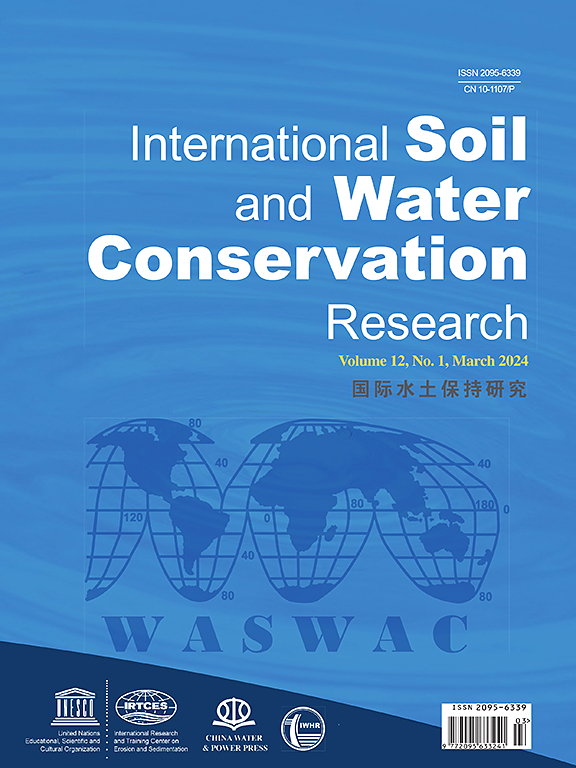受地表覆盖类型影响的降雨强度剖面引起的地表-地下流动和土壤流失变化:长期实地研究
IF 7.3
1区 农林科学
Q1 ENVIRONMENTAL SCIENCES
International Soil and Water Conservation Research
Pub Date : 2024-05-22
DOI:10.1016/j.iswcr.2024.05.003
引用次数: 0
摘要
本文章由计算机程序翻译,如有差异,请以英文原文为准。
Rainfall intensity profile induced changes in surface‒subsurface flow and soil loss as influenced by surface cover type: A long-term in situ field study
Due to global warming, changes in the rainfall intensity profile (i.e., the temporal intensity distribution within a rainfall event) increase the difficulty of accurate erosion prediction and control. Surface cover has been widely used as a critical measure to control soil erosion worldwide. However, the effects of the rainfall intensity profile (RIP) on soil erosion under different surface covers are not fully understood. In this study, long-term in situ field observations of the rain hyetograph, surface runoff coefficient (SRC), subsurface flow rate (SFR), and soil loss rate (SLR) from bare land, litter cover and grass cover were conducted over 11 consecutive years in the red soil hilly region of southern China. According to the occurrence time of the most intense rainfall, 226 erosive events were classified into four RIP patterns: advanced, intermediate, delayed, and uniform patterns. The results indicated that the advanced pattern with short duration–high intensity and the delayed pattern with long duration–high depth contributed to 73.45% of the total erosive events. For bare land, advanced events were the dominant pattern producing surface runoff and soil erosion, accounting for 57.24% and 75.17%, respectively, of the total surface runoff and erosion. The average SRC and SLR from the advanced pattern were 1.29–2.42 times and 2.52–39.78 times greater than those from the other patterns, respectively. The delayed pattern contributed to subsurface flow, and the average SFR was 1.27–2.17 times greater than that of the other patterns. Furthermore, surface cover significantly reduced surface runoff and erosion and increased subsurface flow, especially under the advanced pattern. Both surface cover measures were equally effective in controlling surface runoff and erosion, but the increase in subsurface flow caused by litter cover was 1.38–2.67 times greater than that caused by grass cover. Advanced pattern events increase the erosion risk on red soil slopes, and surface cover effectively weakens the effect of variation in the RIP pattern on soil erosion. Moreover, surface cover significantly alters the surface‒subsurface flow distribution pattern for all the RIP patterns. This study highlights the crucial importance of rain intensity profiles on water erosion and provides a basis for optimizing measures to effectively control soil and water loss under climate change.
求助全文
通过发布文献求助,成功后即可免费获取论文全文。
去求助
来源期刊

International Soil and Water Conservation Research
Agricultural and Biological Sciences-Agronomy and Crop Science
CiteScore
12.00
自引率
3.10%
发文量
171
审稿时长
49 days
期刊介绍:
The International Soil and Water Conservation Research (ISWCR), the official journal of World Association of Soil and Water Conservation (WASWAC) http://www.waswac.org, is a multidisciplinary journal of soil and water conservation research, practice, policy, and perspectives. It aims to disseminate new knowledge and promote the practice of soil and water conservation.
The scope of International Soil and Water Conservation Research includes research, strategies, and technologies for prediction, prevention, and protection of soil and water resources. It deals with identification, characterization, and modeling; dynamic monitoring and evaluation; assessment and management of conservation practice and creation and implementation of quality standards.
Examples of appropriate topical areas include (but are not limited to):
• Conservation models, tools, and technologies
• Conservation agricultural
• Soil health resources, indicators, assessment, and management
• Land degradation
• Sustainable development
• Soil erosion and its control
• Soil erosion processes
• Water resources assessment and management
• Watershed management
• Soil erosion models
• Literature review on topics related soil and water conservation research
 求助内容:
求助内容: 应助结果提醒方式:
应助结果提醒方式:


